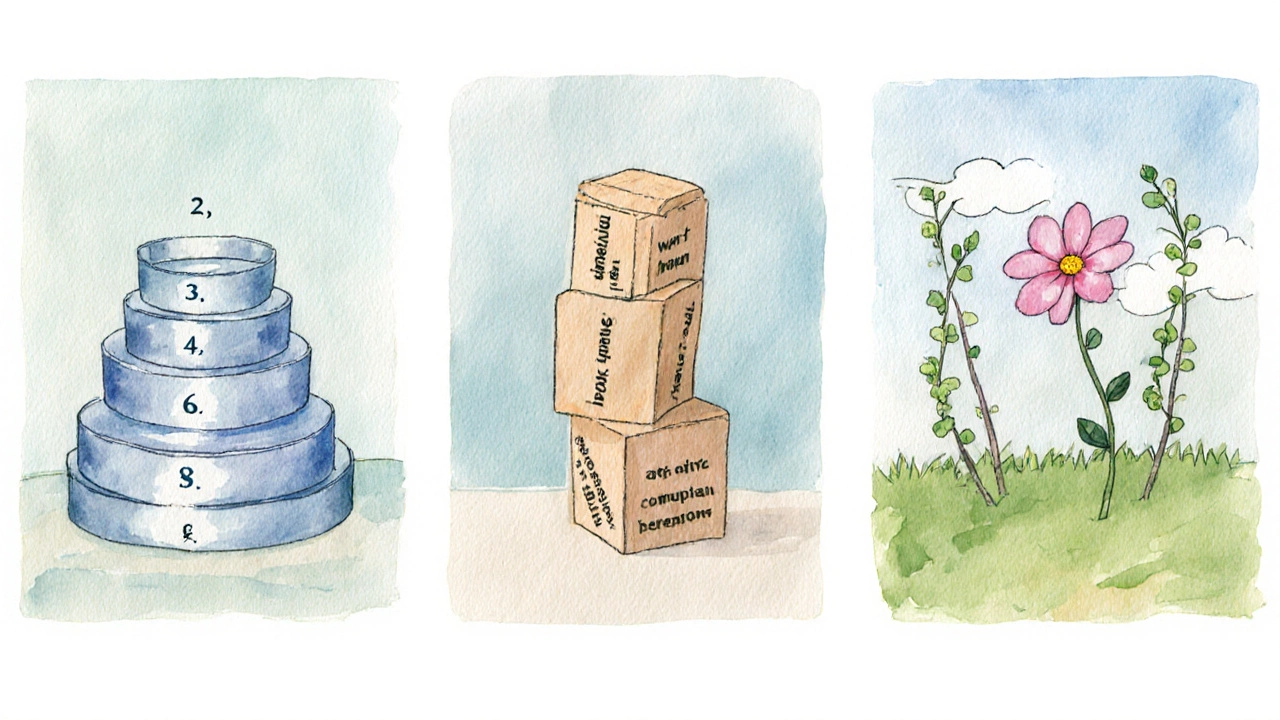What is a Cinquain Poem? Definition, Forms, and How to Write One
 Oct, 8 2025
Oct, 8 2025
Cinquain Poem Generator
How to Use This Tool:
- Select a structure: Classic Syllable-based, Word Count, or Didactic Pattern
- Enter a subject or topic (e.g., "Sunset", "Guitar")
- Click "Generate Poem" to create your cinquain
- Try different subjects to explore various images and emotions
Key Takeaways
- A cinquain is a five‑line poem with a specific syllable or word pattern.
- It was created by American poet Adelaide Crapsey in the early 1900s.
- Three common structures exist: classic syllable‑based, word‑count, and didactic.
- Writing a cinquain involves choosing a clear image, then shaping it into the tight form.
- Cinquains work well in classrooms, workshops, and personal writing practice.
When you hear the term cinquain poem, you might picture a short, tidy stanza that feels like a poetic haiku with a twist. In plain English, a cinquain is a five‑line poem that follows a set of rules for length, rhythm, or word count. The name comes from the Latin word cinque, meaning five, because each poem has exactly five lines. Below you’ll learn what makes a cinquain tick, where it came from, how to craft one, and why it still matters in 2025.
Adelaide Crapsey (1878‑1914) was an American poet who invented the modern cinquain after experimenting with Japanese haiku and English meter.What Exactly Is a Cinquain?
A cinquain is a short poem consisting of five lines that can be organized by:
- Traditional syllable count: 2-4-6-8-2 \n
- Word count: 1-2-3-4-1
- Didactic pattern: title, line, two‑line, two‑line, title (used for teaching)
The poem usually captures a single image or feeling, using crisp language and a natural rhythm. Because the form is so constrained, every word carries weight, making cinquains great practice for beginners and seasoned poets alike.
History: From Haiku to the American Cinquain
In the early 20th century, Adelaide Crapsey studied Japanese haiku and felt that English needed a similar brief form that respected its own stress patterns. She crafted the 2‑4‑6‑8‑2 syllable structure, publishing her first cinquains in the 1904 edition of Poetry magazine. Though she died young, her format survived through school textbooks and poetry workshops, becoming a staple of American verse.

Core Structure: How the Lines Break Down
Let’s look at the three most popular layouts.
- Syllable‑Based (Classic) Cinquain:
- Line1 - 2 syllables
- Line2 - 4 syllables
- Line3 - 6 syllables
- Line4 - 8 syllables
- Line5 - 2 syllables
- Word‑Count Cinquain (often taught in elementary schools):
- Line1 - 1 word
- Line2 - 2 words
- Line3 - 3 words
- Line4 - 4 words
- Line5 - 1 word
- Didactic Cinquain (used for learning parts of speech):
- Line1 - Title (noun)
- Line2 - One adjective describing the title
- Line3 - Two‑line description, often a verb phrase
- Line4 - Two‑line emotional or sensory reaction
- Line5 - Repeat of the title or a concluding noun
Each version still respects the five‑line rule, but the focus shifts: syllable‑based emphasizes rhythm; word‑count focuses on brevity; didactic versions teach structure.
How to Write Your First Cinquain - Step by Step
- Pick a vivid image. Think of a single scene-a sunrise, a rusted bike, the smell of rain.
- Choose the format. For beginners, the 1‑2‑3‑4‑1 word count is easiest.
- Draft the title line. If you use a title‑based form, write a noun that names your subject.
- Count syllables or words. Use a phone app or a simple tongue‑tap to verify the count.
- Polish the language. Replace weak adjectives with sensory verbs. Aim for a natural breath‑like rhythm.
- Read aloud. The poem should feel like a quick breath, ending with a pause after the final line.
Here’s a quick illustration using the classic syllable structure:
Winter
Silent snow
Blanketing the tired earth
Whispers of cold wind through the trees
Quiet
This example follows 2‑4‑6‑8‑2 syllables and captures a single, vivid moment.
Tips, Tricks, and Common Pitfalls
- Don’t force rhyme. Cinquains work best without forced end‑rhymes unless you’re aiming for a lyrical style.
- Limit adjectives. Too many descriptors can clutter the tight space; choose the most evocative ones.
- Use strong verbs. Action words add momentum, especially in the longer third and fourth lines.
- Stick to one focus. A cinquain should not shift subjects midway; keep the image consistent.
- Play with line breaks. Visual placement on the page can reinforce meaning-for instance, breaking a phrase at an emotional pivot.
Real‑World Examples and What Makes Them Work
Below are three diverse cinquains, each showcasing a different structure.
- Classic (2‑4‑6‑8‑2)
Thunder
Low rumble
Rolling across the distant hills
Lightning splits the black night, startling the sleeping town
Boom - Word‑Count (1‑2‑3‑4‑1)
Ocean
Salty breath
Waves crash, gulls cry
Sunset paints glassy horizon gold
Depth - Didactic
Garden
Blooming
Colors burst, insects dance
Sunlight kisses each petal, earth hums softly
Garden
Notice how each poem sticks to a single scene, uses precise verbs, and ends with a word that feels like a gentle exhale.

Comparing Cinquain with Other Short Forms
| Form | Lines | Syllable/Word Pattern | Typical Origin | Common Use |
|---|---|---|---|---|
| Cinquain | 5 | 2‑4‑6‑8‑2 (syllable) or 1‑2‑3‑4‑1 (word) | Early 1900s, USA | Classroom exercises, quick imagery |
| Haiku | 3 | 5‑7‑5 syllables | Japan, 17th‑18thc. | Nature snapshots, seasonal references |
| Tanka | 5 | 5‑7‑5‑7‑7 syllables | Japan, ancient court poetry | Extended emotion, love, reflection |
| Clerihew | 4 | Irregular, comedic | England, early 1900s | Humorous biographical verses |
While all four are brief, the cinquain stands out for its flexible word‑count version, making it accessible for students who may struggle with exact syllable counting.
Using Cinquains in Teaching and Creative Workshops
Because the form is simple yet demanding, teachers love it for building observation skills. A typical classroom activity:
- Take the class outside for five minutes of quiet observation.
- Ask each student to note one vivid detail.
- Guide them through the 1‑2‑3‑4‑1 word count, filling in each line together.
- Share aloud; discuss how word choice changes mood.
Writers’ groups also use cinquains as warm‑up prompts before tackling longer pieces. The rapid feedback loop helps participants focus on precision.
Common Questions About Cinquains
Frequently Asked Questions
Can I rhyme a cinquain?
Rhyme isn’t required, but a subtle rhyme can add musicality. If you choose to rhyme, make sure it doesn’t force awkward word choices.
Is the syllable count strict?
For the classic form, yes-2‑4‑6‑8‑2 is the hallmark. Modern poets sometimes relax the rule, but deviating turns the piece into a free‑verse five‑liner rather than a true cinquain.
What’s the difference between a cinquain and a tanka?
Both have five lines, but a tanka follows a 5‑7‑5‑7‑7 syllable pattern rooted in Japanese tradition. A cinquain uses 2‑4‑6‑8‑2 or a word‑count model developed in the United States.
Can I write a narrative using only cinquains?
Yes. Poets sometimes string together a series of cinquains-called a cinquain sequence-to tell a longer story while keeping each fragment tight.
Are cinquains suitable for social media captions?
Absolutely. Their brevity fits platforms like Instagram or Twitter, and the structured rhythm can make a caption feel more poetic.
Whether you’re a student, a teacher, or just someone looking for a quick creative outlet, the cinquain offers a compact playground for language. Grab a notebook, choose a single image, follow the five‑line blueprint, and watch how a handful of words can paint a vivid picture.